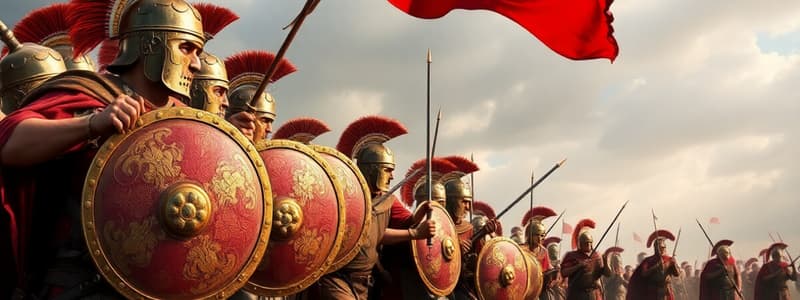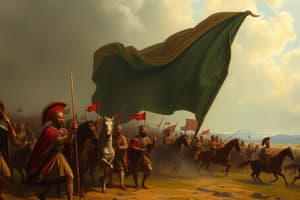Podcast
Questions and Answers
In the early centuries of Rome, what characterized the nature of conflicts?
In the early centuries of Rome, what characterized the nature of conflicts?
- Organized slave revolts challenging Roman authority.
- Large-scale wars aimed at complete annihilation of rival city-states.
- Frequent small conflicts between neighboring communities for resources and frontier territories. (correct)
- Naval battles dominating control over the Mediterranean Sea.
What strategic advantage did Rome gain from its geographic location?
What strategic advantage did Rome gain from its geographic location?
- Extensive farmlands.
- A natural harbor for naval dominance.
- Control of a ford on the Tiber River. (correct)
- Access to gold mines.
What role did the Roman calendar play in relation to warfare?
What role did the Roman calendar play in relation to warfare?
- It tracked the number of soldiers conscripted each year.
- It designated specific months for military training exercises.
- It dictated the religious ceremonies to be performed before each battle.
- It included festivals marking the beginning and end of the 'war season'. (correct)
What was the nature of Rome's power over smaller Latin communities before the 4th century BCE?
What was the nature of Rome's power over smaller Latin communities before the 4th century BCE?
Prior to the 4th century BCE, how did Rome compare to other city-states in central Italy?
Prior to the 4th century BCE, how did Rome compare to other city-states in central Italy?
During the late 7th and early 6th centuries BCE, what military influence is evident in the equipment of Roman warriors?
During the late 7th and early 6th centuries BCE, what military influence is evident in the equipment of Roman warriors?
Artistic depictions of early Roman soldiers show them using what mode of transport while following chieftains?
Artistic depictions of early Roman soldiers show them using what mode of transport while following chieftains?
What does the content suggest about the composition of the early Roman army, compared to armies from other areas, such as Greece?
What does the content suggest about the composition of the early Roman army, compared to armies from other areas, such as Greece?
Besides hoplite gear, what other military hardware was used by Roman soldiers of the time?
Besides hoplite gear, what other military hardware was used by Roman soldiers of the time?
Starting from the 6th century BCE, what form of government did Rome adopt?
Starting from the 6th century BCE, what form of government did Rome adopt?
During the early 4th century BCE, what key event marked the beginning of Roman expansion in Central Italy?
During the early 4th century BCE, what key event marked the beginning of Roman expansion in Central Italy?
What term was used to describe areas under Roman control after the 4th century BCE?
What term was used to describe areas under Roman control after the 4th century BCE?
What occurred during the second half of the 4th and early 3rd centuries BCE that significantly expanded Rome's influence?
What occurred during the second half of the 4th and early 3rd centuries BCE that significantly expanded Rome's influence?
Which conflict directly preceded Roman conquest of South Italy?
Which conflict directly preceded Roman conquest of South Italy?
Visual sources from Rome in the 3rd century BCE show soldiers carrying what?
Visual sources from Rome in the 3rd century BCE show soldiers carrying what?
What military adaptation became more prevalent among the populations of the southern areas influenced by Rome during the 3rd century BCE?
What military adaptation became more prevalent among the populations of the southern areas influenced by Rome during the 3rd century BCE?
What type of helmet became standard equipment for the Roman legions?
What type of helmet became standard equipment for the Roman legions?
What restrictions applied to Roman citizens eligible for army service before the 2nd century BCE?
What restrictions applied to Roman citizens eligible for army service before the 2nd century BCE?
How did recruits of the early Roman army equip themselves?
How did recruits of the early Roman army equip themselves?
What was the typical duration and operational status of Roman armies before the 2nd Century BCE?
What was the typical duration and operational status of Roman armies before the 2nd Century BCE?
Flashcards
Beginnings of Rome
Beginnings of Rome
Rome began as a city-state controlling a strategic point, specifically a ford on the Tiber River.
Early Roman conflicts
Early Roman conflicts
In early centuries, Rome faced frequent small conflicts with neighbors over resources and territories, rather than large wars.
Roman war season
Roman war season
The Roman calendar marked the start and end of the war season with festivals in March and October.
What is hegemony?
What is hegemony?
Signup and view all the flashcards
Early Roman Equipment
Early Roman Equipment
Signup and view all the flashcards
Early Roman soldiers' gear
Early Roman soldiers' gear
Signup and view all the flashcards
Early Roman tactics
Early Roman tactics
Signup and view all the flashcards
Roman Republic
Roman Republic
Signup and view all the flashcards
Veii's annexation
Veii's annexation
Signup and view all the flashcards
Roman 'Imperium'
Roman 'Imperium'
Signup and view all the flashcards
Samnite wars and campania
Samnite wars and campania
Signup and view all the flashcards
War against Pyrrhus
War against Pyrrhus
Signup and view all the flashcards
Hoplite Gear prestige
Hoplite Gear prestige
Signup and view all the flashcards
New Roman army equipment
New Roman army equipment
Signup and view all the flashcards
Lighter Roman army equipment
Lighter Roman army equipment
Signup and view all the flashcards
The Montefortino helmet
The Montefortino helmet
Signup and view all the flashcards
Esquiline Gate Painting
Esquiline Gate Painting
Signup and view all the flashcards
Early Roman Militia
Early Roman Militia
Signup and view all the flashcards
Recruit arming cost
Recruit arming cost
Signup and view all the flashcards
Stipendium Roman army
Stipendium Roman army
Signup and view all the flashcards
Study Notes
- Ancient Rome transitioned from a city-state to an empire through warfare.
The Beginnings of Rome
- Rome began as a city-state strategically located at a ford on the Tiber River.
- Rome frequently engaged in small conflicts with neighboring communities to acquire resources and control frontier territories.
- The Roman calendar designated March and October for festivals marking the start and end of the "war season."
Expansion of Roman Territory
- Rome established hegemony over smaller Latin communities.
- Rome was one of many city-states in central Italy until the 4th century BCE.
Equipment of Early Roman Warriors
- Roman warrior equipment became similar to that of Greek hoplites in the late 7th/early 6th century BCE (Archaic Period).
- Artistic depictions show foot soldiers with spears, helmets, and hoplite shields, wearing bronze or linen body armor.
- Chieftains rode on chariots, viewed as a means of transportation rather than a fighting platform.
- Cavalry, also armed like hoplites, were depicted.
Tactics of Early Roman Warfare
- Scholars doubt the existence of a sizable class of independent landowners forming a true hoplite army in phalanx formation because of Italy's elitist social structure.
- Soldiers with hoplite gear were likely few, supported by numerous light infantry.
- Roman hoplite-like soldiers used throwing spears and more open formations, similar to early Greek hoplites.
- Throwing spears remained a feature of Italian warfare longer than in Greece.
- Rome adopted a republican government with elected magistrates, a council, and popular assemblies by the 6th century BCE.
Timeline of Early Roman Conquest
- Rome annexed the Etruscan city of Veii in the early 4th century BCE.
- This annexation marked the beginning of Roman expansion in Central Italy; conquered communities largely became allies of Rome.
- The area under Roman control was called "imperium".
- During the second half of the 4th and early 3rd centuries BCE, Rome conquered Campania, leading to the "Samnite Wars" against Apennine highlanders.
- From 282-275 BCE, Rome fought a war against King Pyrrhus, resulting in the Roman conquest of South Italy.
The Evolution of the Roman Army
- Hoplite gear was prominent in the art of Central Italy during the 4th century BCE.
- Depictions may not be accurate, or they may emphasize hoplite weaponry for traditional prestige.
- Visual sources from Rome in the 3rd century BCE depict soldiers with long oval shields and open face helmets with folding cheek guards.
- Central and Southern Italy also had lighter equipment and more reliance on throwing spears/javelins.
- Use of this lighter gear and throwing spears may have influenced the Romans.
- Rome integrated these warriors into the army as allies.
- The "Montefortino" type bronze helmet became standard for Roman legions.
Citizen Army
- The Roman army operated as a militia until the 2nd century BCE.
- All citizens were eligible, with exceptions for those whose property fell below a minimum value (the Proletarii).
- Recruits armed themselves at their own expense.
- Armies were temporary, disbanded after campaigns.
- The state provided stipendium (military pay) in the 4th century BCE, which theoretically allowed the army to stay in service all year.
- Campaigns were usually a few weeks in summer.
- Rome did not usually employ mercenaries due to the large number of available citizens and allies.
Studying That Suits You
Use AI to generate personalized quizzes and flashcards to suit your learning preferences.





